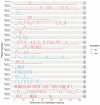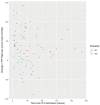Conscious prone positioning during non-invasive ventilation in COVID-19 patients: experience from a single centre
- PMID: 33110499
- PMCID: PMC7578762
- DOI: 10.12688/f1000research.25384.1
Conscious prone positioning during non-invasive ventilation in COVID-19 patients: experience from a single centre
Abstract
Critically ill patients admitted to hospital following SARS-CoV-2 infection often experience hypoxic respiratory failure and a proportion require invasive mechanical ventilation to maintain adequate oxygenation. The combination of prone positioning and non-invasive ventilation in conscious patients may have a role in improving oxygenation. The purpose of this study was to assess the effect of prone positioning in spontaneously ventilating patients receiving non-invasive ventilation admitted to the intensive care. Clinical data of 81 patients admitted with COVID 19 pneumonia and acute hypoxic respiratory failure were retrieved from electronic medical records and examined. Patients who had received prone positioning in combination with non-invasive ventilation were identified. A total of 20 patients received prone positioning in conjunction with non-invasive ventilation. This resulted in improved oxygenation as measured by a change in PaO 2/FiO 2 (P/F) ratio of 28.7 mmHg while prone, without significant change in heart rate or respiratory rate. Patients on average underwent 5 cycles with a median duration of 3 hours. There were no reported deaths, 7 of the 20 patients (35%) failed non-invasive ventilation and subsequently required intubation and mechanical ventilation. In our cohort of 20 COVID-19 patients with moderate acute hypoxic respiratory failure, prone positioning with non-invasive ventilation resulted in improved oxygenation. Prone positioning with non-invasive ventilation may be considered as an early therapeutic intervention in COVID-19 patients with moderate acute hypoxic respiratory failure.
Keywords: COVID-19; Intensive Care; Non-invasive ventilation; Prone.
Copyright: © 2020 Burton-Papp HC et al.
Conflict of interest statement
No competing interests were disclosed.
Figures


Similar articles
-
Feasibility and physiological effects of prone positioning in non-intubated patients with acute respiratory failure due to COVID-19 (PRON-COVID): a prospective cohort study.Lancet Respir Med. 2020 Aug;8(8):765-774. doi: 10.1016/S2213-2600(20)30268-X. Epub 2020 Jun 19. Lancet Respir Med. 2020. PMID: 32569585 Free PMC article. Clinical Trial.
-
Prone positioning in patients treated with non-invasive ventilation for COVID-19 pneumonia in an Italian emergency department.Emerg Med J. 2020 Sep;37(9):565-566. doi: 10.1136/emermed-2020-209744. Epub 2020 Jul 6. Emerg Med J. 2020. PMID: 32748797 Free PMC article.
-
Prone Position and Lung Ventilation and Perfusion Matching in Acute Respiratory Failure due to COVID-19.Am J Respir Crit Care Med. 2020 Jul 15;202(2):278-279. doi: 10.1164/rccm.202003-0775IM. Am J Respir Crit Care Med. 2020. PMID: 32437251 Free PMC article. No abstract available.
-
COVID-19 pandemic and non invasive respiratory management: Every Goliath needs a David. An evidence based evaluation of problems.Pulmonology. 2020 Jul-Aug;26(4):213-220. doi: 10.1016/j.pulmoe.2020.04.013. Epub 2020 Apr 27. Pulmonology. 2020. PMID: 32362507 Free PMC article. Review.
-
Electrical Impedance Tomography and Prone Position During Ventilation in COVID-19 Pneumonia: Case Reports and a Brief Literature Review.Semin Cardiothorac Vasc Anesth. 2020 Dec;24(4):287-292. doi: 10.1177/1089253220958912. Epub 2020 Sep 13. Semin Cardiothorac Vasc Anesth. 2020. PMID: 32924792 Review.
Cited by
-
Awake prone positioning for patients with COVID-19-related respiratory failure: a systematic review and meta-analysis.Intern Emerg Med. 2024 Jan;19(1):147-158. doi: 10.1007/s11739-023-03434-1. Epub 2023 Oct 5. Intern Emerg Med. 2024. PMID: 37796372 Free PMC article.
-
Various Aspects of Non-Invasive Ventilation in COVID-19 Patients: A Narrative Review.Iran J Med Sci. 2022 May;47(3):194-209. doi: 10.30476/ijms.2021.91753.2291. Iran J Med Sci. 2022. PMID: 35634520 Free PMC article. Review.
-
Effect of prone versus supine position in COVID-19 patients: A systematic review and meta-analysis.J Clin Anesth. 2021 Nov;74:110406. doi: 10.1016/j.jclinane.2021.110406. Epub 2021 Jun 22. J Clin Anesth. 2021. PMID: 34182261 Free PMC article.
-
Awake prone positioning for COVID-19 hypoxemic respiratory failure: A rapid review.J Crit Care. 2021 Feb;61:63-70. doi: 10.1016/j.jcrc.2020.08.018. Epub 2020 Aug 27. J Crit Care. 2021. PMID: 33096347 Free PMC article. No abstract available.
-
Conscious prone positioning in nonintubated COVID-19 patients with acute respiratory distress syndrome: systematic review and meta-analysis.Crit Care Sci. 2024 Apr 8;36:e20240176en. doi: 10.62675/2965-2774.20240176-en. eCollection 2024. Crit Care Sci. 2024. PMID: 38597483 Free PMC article.
References
MeSH terms
Associated data
LinkOut - more resources
Full Text Sources
Miscellaneous

